► CAR adventures with a Pontiac Aztek
► Road-tripping through barren California
► Can we sell it on without losing money?
‘Her ex-boyfriend kicked-in the windshield. He also jumped on the hood.’ Too much information, but it’s reassuring to learn that the person-shaped frontal damage to the Aztek I’m checking out was at least inflicted willingly. Every atom of the secondhand Pontiac displays evidence of a tortured past. I should, I know, be running down the street just as fast as I can. The centre console’s been booted through the dashboard and the interior, from carpet to headliner, is mottled red and brown like the inside of a sticking plaster. The odometer shows 200,000 miles. It may as well be half a million.
‘I’ll tow it home for you!’ The alarm bells, which were already merrily bonging away in my head, go into overdrive. But I’m a sucker for a narrative and this one’s a heartbreaker. He’s on a drip, recovering from an operation. His daughter’s just out of rehab. I want to give him my money: I’m just not sure I want this car in return.
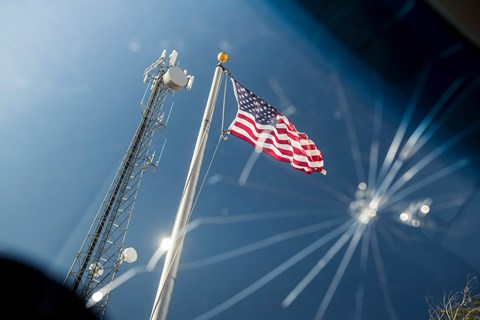
We’re in Palm Springs, California, here to see some of the state’s less travelled backwaters from the seat of one of the most disastrous cars in the history of American car-making. A regular ‘winner’ in list stories of the worst cars of all time, and variously described as ‘looking like an angry kitchen appliance’ and like ‘something dogs bark at and cathedrals employ to ring bells’, the Aztek was largely ignored on America’s West Coast – until 2008.
Unlikely fame arrived when the car was cast as the beautifully metaphoric personal transportation of destitute and desperate protagonist Walter White in the hit TV show Breaking Bad. Since then a millennial hunger for all things ironic has pushed up the price of well-kept examples. The Aztek sitting before me is not well kept, but the heavy dose of patina makes it pretty perfect for my purposes – to buy it, to drive and to sell it without losing so much money I’m forced to become a narco baron myself.

Born from the mind of GM designer Tom Peters as ‘Bearclaw’, a squat, aggressive crossover SUV concept based on the fourth-gen Chevy Camaro, the production Aztek instead arrived at the 2000 Detroit auto show as a slab-sided minivan teetering atop tiny wheels and a border wall of concrete-grey plastic cladding. A victim of financial stick-whittling and world-class corporate mission drift, the unveil pushed hard to convince the press otherwise, with an atomic blast of ‘active lifestyle’ messaging. Predictably, the public despised it. ‘I wouldn’t take it as a gift,’ a GM focus-group attendee famously declared. Sales went to the Hyundai Santa Fe at a rate of four to one, and the car was redesigned after only five months. GM forecast sales of up to 75,000 units a year, and needed to flog 30,000 to break even. Even in the car’s best-selling year, 2002, it didn’t come close.
None of the Aztek’s many active lifestyle baubles, such as a cargo area stereo system, integrated air compressor, air mattress or camping tent feature on our vehicle, an early 2001 base-spec example with two-wheel drive (four-wheel drive was an option) and grubby cloth seats. An integrated drinks cooler – which would have once occupied the chasm between the sweat-matted, filthy front seats – is long gone.
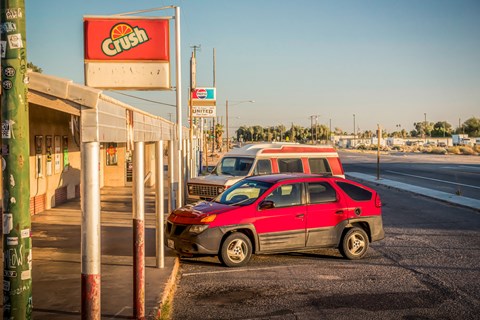
Despite its sad appearance, this hard-run Aztek of ours still drives well, with an old school body-on-frame robustness and the kind of abundant power often observed in hard-ridden engines homing-in on catastrophic failure. Steering is light but accurate through the thick, foamy steering wheel, the brakes function well enough, and the stout four-speed transmission shifts through all gears with a suspiciously assertive clunk.
There is, however, one critical issue with this particular car – the engine warning light, wholesomely displayed as ‘Service Engine Soon’ on the instrument cluster. In California, the Union’s most emissions-focused state, this means I cannot register a change of ownership to me, or move it on to someone else. The car becomes my problem until the issue is fixed, or the car is scrapped. I decide – perhaps naively – this is no big deal, gambling that a couple of hours of long-overdue basic maintenance might correct the situation.
It doesn’t.
‘Catalyst: not passed. Evaporative System: not passed. Secondary Air System: not passed. P0301: cylinder 1 misfire, confirmed.’
In 1988, Californian air-quality legislators mandated all new vehicles sold in the state be capable of reporting and storing emissions-specific diagnostic information using a system called Onboard Diagnostics. A standardised version of this system became mandatory for all vehicles sold in the US after 1996. Europe followed suit in 2001, then Australia in 2006, and China in 2008.
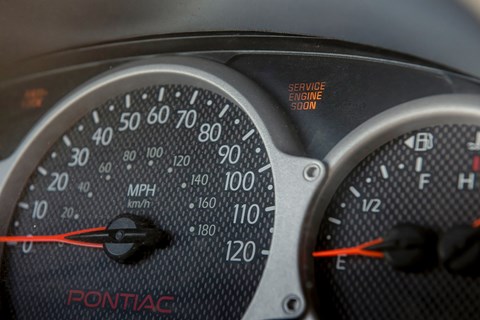
The modern version of that system, OBD-II, constantly monitors the functioning of a vehicle, reporting a standardised series of diagnostic trouble codes when something is amiss. Like a British MoT, the presence of any emissions-related codes in the car’s ECU will fail a California smog test. To pass a retest, the fault must be rectified, the codes reset, and the car complete a self-check during a ‘drive cycle’ to ensure it’s functioning correctly. With some borrowed tools and a wodge of fading optimism, I get busy.
Replacing the plugs and leads and an EGR valve gasket fails to impress my code scanner. Suspecting imminent head-gasket failure, I draw the line at replacing it. The Aztek’s big, longitudinally-mounted 3.4-litre V6 is rammed so close to the firewall that pulling it out – together with the fragile, crumbling emissions system atop the engine – is widely regarded as the work of a full day, a day covered in sweat, blood from battered knuckles and old oil. No thanks – I’ll try my luck. A local testing station recommends resetting the light once more, followed by a drive cycle.
‘How long is a drive cycle?’ I ask. ‘No idea,’ comes the reply, delivered with a faint smile. ‘Sometimes 15 minutes, sometimes a few hundred miles. Just drive it somewhere that isn’t here…’ I know just the place.
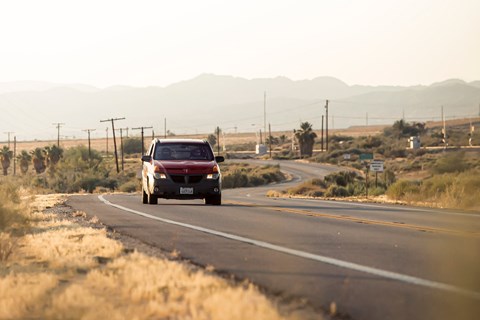
Three hours’ drive east of Los Angeles, at a depth of 227 feet below sea level, lies a freak environmental disaster that would have left those early Californian air quality legislators gasping for adjectives. The Salton Sea is a 340-square-mile lake, formed in 1905 when floods breached a levee on the Colorado River. The spill took three years to contain, after which ‘the miracle in the desert’ – then a beautiful shining body of fresh water amid the sun-drenched California desert – quickly became a popular recreation area. Tourism declined equally rapidly in the ’70s, when pollutants from intensive farming in the area were found to have leached into the basin. Then, in 2003, a scheme to divert water to the nearby cities of Los Angeles and San Diego severely reduced inflow, shrinking the lake and exposing a shoreline of toxic waste. Today, wind-borne lake-bed dust, heavy with arsenic and selenium, gives the surrounding valley some of the worst air quality in the US.
A dried lake of nasty chemicals in the desert feels like the perfect destination for a car made famous by a TV show about cooking a bunch of nasty chemicals in the desert, and a 180-mile orbit of this hellscape should provide enough time for the car to decide its own fate. With error codes erased and the warning light extinguished, I set off.
You smell the Salton Sea before you can see it. Beaches formed from the decaying bones of several million dead fish line the shore. Either side of the highway, ordered rows of palm trees create a shifting kaleidoscope of geometric patterns amid a low, brown haze. I arrive at Salton City, a pulverised beach resort of 12,000 mostly vacant lots, established in 1958 and abandoned in the mid ’70s. The engine stumbles and dies as I slow for an empty intersection…
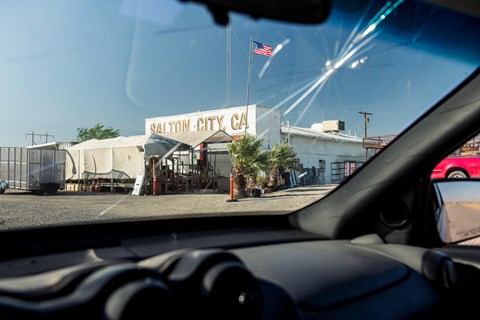
The car coasts silently along, rocking in the wind as the fuel gauge, previously noted as being somewhat optimistic, clacks to zero in a single move. Conveniently, I am directly across from a solitary fuel station. Pushing the Aztek across six lanes of freeway is more Active Lifestyle than I bargained for, but I’m lucky this has happened here – it sure beats dying on an unplanned hike through the 40° heat of this scorched and desolate desert valley.
A group of kids shout from across the forecourt as I roll the car up to the pump. ‘The Walter White car!’ I wonder whether they’re old enough to have been watching the show, and whether they would have understood the nuances of the storyline, and… More to the point, how the hell did they get out here? Getting around this enormous, empty and inhospitable place without a car is impossible. Throughout most of rural America there is no local public transport system. Tired, domestic-market automotive cockroaches, kept running into the winters of their lives with cheap foreign-made parts, do the work of buses and trains. For most working Americans, in particular the huge chunk of the population that exist from pay day to pay day, owning a car is fundamental to their existence.
Rounding the south-east end of the lake on a full tank of 87 octane, the surrounding fields turn greener, larger and flatter. The sulphurous hum of rotting fish gives way to the acrid stench of a 95,000-head cattle farm. Weeping industrial by-product of this area set in motion the Salton Sea ecological disaster. We’re deep in a forgotten corner of the United States, out of view, where things like this – and worse – go unchecked and continue unabated.
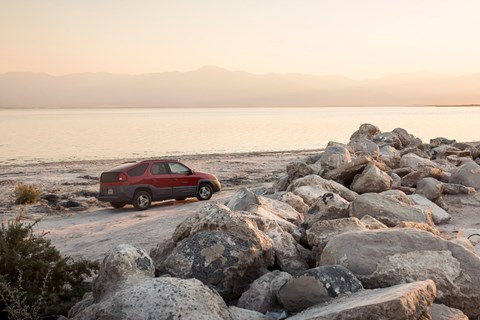
I stop in Niland, another crumbling agricultural town, outside a supermarket with a hand-painted sign. Loneliness wraps this place in an ominous stillness, and the low evening sun rakes along the side of the Aztek, picking out a moonscape texture of myriad scrapes and dents. The silence is punctured by the laboured cranking of an engine that won’t start – and this time, miraculously, it’s not mine. Road Karma dictates not leaving anyone stranded in places like this, even if stopping to assist feels risky.
My offer of help is initially rebuffed, until, noticing the condition of my Aztek, the owner caves in and allows me to dig around his ageing Ford Econoline van conversion. I chase the issue to a spark problem – a faulty ignition control module, an emissions-compliance Band-Aid mounted on the distributor of the ancient 5.8-litre V8, which needs to be replaced.
Throwing a chain around the Aztek’s rear beam axle, I drag the Ford heap to a mechanic across town, and drop the owner home in nearby Slab City, a peaceful but proudly lawless squatter commune located on the site of an ex-World War 2 Marine Corps barracks. On my way back out, the track ends and I become lost in the darkness. I’m hundreds of miles from anyone I know, without food or water, bouncing through the desert at night, alone. So much for Road Karma.
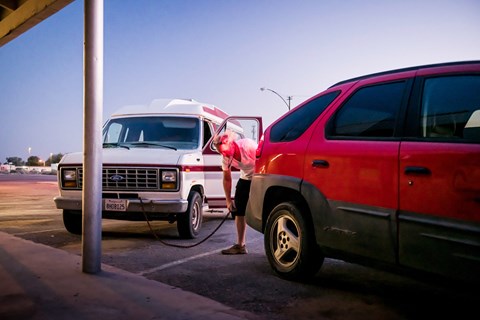
I chance upon some power lines – always a reassuring sign that civilisation isn’t too far away – and drag the Aztek’s chassis through a series of deeply-rutted washes and over railway lines until I’m back onto pavement again. Pushing north along the east shore of the lake, there’s time to ponder just how badly things could have turned out, and I’m grateful to the Pontiac for not giving up. It’s been running perfectly for the better part of half a day, the engine light remains off, and it feels good to be back on a smooth surface once again – for all its lifestyle pretensions the Aztek doesn’t bash dirt tracks like a pure-bred off-roader.
Eventually the wall of darkness beyond the meagre throw of the headlights, yellowed and fogged with age as they are, gives way to the floodlit glare of an inland Border Patrol checkpoint – one of 33 permanent (and permanently controversial) traffic stops near the Mexican/US border. I pass though without question, but just a few miles further on a patrol truck signals for me to pull over. I shut off the car and the agents approach, their flashlights dancing across the rear windows and briefly illuminating my pessimistic collection of oil and coolant bottles strewn across the rear passenger seat.
I have no straightforward answer as to why I’m out here in a smashed-up car that I don’t yet technically own, and instead work my way through the story idea, the misguided purchase, the hopeful drive cycle, and the car’s TV ‘provenance’.
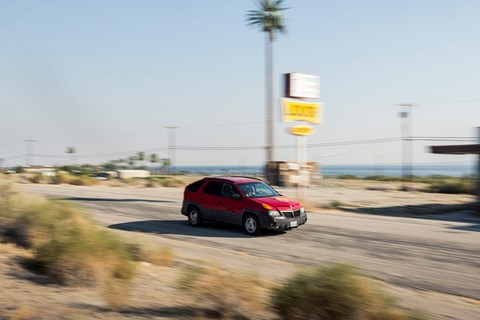
‘He’s right – it’s Walter White’s car.’ One of them’s seen the show, and thankfully neglects to mention to his partner that the character, in addition to driving an Aztek, is also a prolific meth cook prone to unspeakable violence, much of it occurring in the desert near the Mexican border…
I’m free to go. I turn the key. The motor stumbles, rattles with a momentary misfire, then throws up the dreaded Service Engine Soon light. Balls.
Passing the north-west end of the lake, I turn for base. Soon we’re back on the freeway, the landscape now an incessant procession of casinos and fuel stations. The orange warning light glares at me from the dorky instrument cluster but the Aztek clips along just fine, radio on, air-con gently blowing.
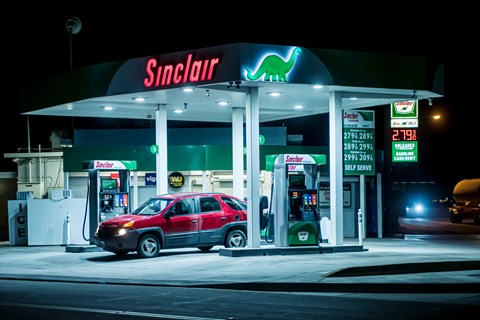
Heinous design, in concert with ordinary and economical underpinnings, guaranteed the Aztek its place in America’s rural public transport system. If the State of California didn’t now require that this one be removed from circulation, rudely making impossible my dream of selling it for the same money I paid for it and breaking even, I have no doubt it could deliver another 100,000 miles of economical and almost-faithful service to someone who needed it. But I can’t sell it and I can’t keep it. It has no future, and certainly no value. Once again – and for the last time in this car’s case – the Aztek comes up short.
Breaking Bad and the Aztec
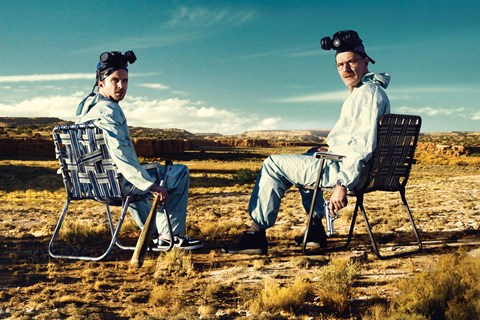
Vince Gilligan’s 2008 drama has rightly taken its place among the most lauded TV shows ever made. Bryan Cranston stars as Walter White, a high school science teacher who learns he has terminal cancer and, with the help of a shady former student, starts ‘cooking’ meth as a way to provide for his family after he’s gone.
Packed with heavyweight performances, great chemistry (both literal and figurative) and a story that sees an avuncular husband and father turn into a ruthless narco baron, Breaking Bad is the ultimate villain origin story. The Aztek, the embodiment of an underwhelming product, perfectly encapsulates the suburban dad White starts out as: a manifestation of his failed ambitions and humdrum life.
By James Dyer, digital editor-in-chief, Empire magazine
The car’s the unlikely star
Walt’s was beige
So fundamental was the Aztek to Walter White’s character that the show’s creator had him lined up to drive one from day one. The colour, too, was no accident – Walt’s car was a suitably forgettable beige 2004 example. Believe it or not, a red Aztek like ours served as pace car for the 2001 Daytona 500.
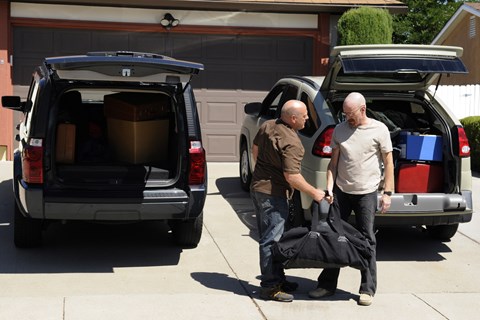
Broken screen?
In the series a broken windscreen becomes a recurring theme, with Walter first being pulled over for damage caused by falling debris from a plane. Walt rants to the lawman at the injustice of it all – we choose not to do the same in conversation with border patrol officers…
Plastic-clad
Grey ‘go-anywhere’ body cladding marks our 2001 car out as an early example – the Aztek switched to body-coloured cladding for 2002. For maximum Breaking Bad authenticity we should have replaced the driver’s side rear alloy with a steel wheel.
Sold for $50
In the opening episode of season five, Walt sells his Aztek for $50 (we can only dream…). It’s the perfect metaphor for the completion of his transformation from meek school teacher and family man to drug baron – in selling the Pontiac he renounces the last vestiges of his old life.
Read more CAR features here